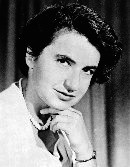

 | | 
|
|---|
 Nearly a half a century ago, scientists were racing to discover the secret of life. A leader in this endeavor was Rosalind Franklin, a young, outstanding British researcher who was working on DNA. She discovered enough information about DNA to provide the basis for an explanation of heredity.
Nearly a half a century ago, scientists were racing to discover the secret of life. A leader in this endeavor was Rosalind Franklin, a young, outstanding British researcher who was working on DNA. She discovered enough information about DNA to provide the basis for an explanation of heredity.
Rosalind Elise Franklin was born July 25, 1920, in London to a prosperous family. As a youngster she preferred building things rather than playing with dolls. Later she developed a passion for astronomy, physics, and chemistry. Her desire to attend Cambridge University was coldly accepted by her father who thought young ladies of Rosalind's stature should concentrate on volunteer work. Eventually, she entered and graduated from Cambridge University.
Rosalind was fascinated by matter - what the world was made of, how it was formed. She was quick and fierce in this pursuit, searching for indisputable, provable facts, not high-flown theories or insubstantial speculation. While still in her early twenties, she discovered structural changes that happen to coal and its carbons when heated. These findings established her reputation as a superb experimentalist. Having accepted an academic position at King's College, she joined the research scientists studying living cells and making X-ray images of DNA molecules. It was here, in 1952, that Rosalind painstakingly conceived of and captured "photograph 5" of the "B" form of DNA. This now-famous image shows a distinctive X shape, suggesting that DNA had a twisted or helical shape. Because Rosalind worked on absolute proofs, she did not dare make the crucial intuitive leap to suggest that DNA is a double helix, shaped like a twisted ladder. When, however, Franklin's data was passed to Watson and Crick (without Franklin's knowledge), they put all the pieces together and created, in l953, the double helical model of DNA. Decoding the structure of DNA was the single most important advancement of modern biology!
After leaving King's College, Rosalind used her X-ray crystallographic skills to perform exceptional research on RNA viruses. She died in l958 of ovarian cancer at age 37 without ever knowing the magnitude of her contribution to the secret of life. In her brief career, Rosalind contributed greatly to the scientific field of molecular biology. As a human being, she was fun-loving, slightly prankish, with a slightly mischievous wit. A most negative comment about Rosalind was that she wouldn't put up with nonsense. Her finely honed intelligence, devotion to the highest standards of research, thoughtful mentoring, unwavering loyalty to friends, and deep commitment to social justice made her truly one of a kind.
— Written by Auste Vygantes
Note: Finch University of Health Sciences in North Chicago, IL was recently renamed the Rosalind Franklin University of Medicine and Science. The faculty, especially those that are chemists, are extremely proud of the new name.